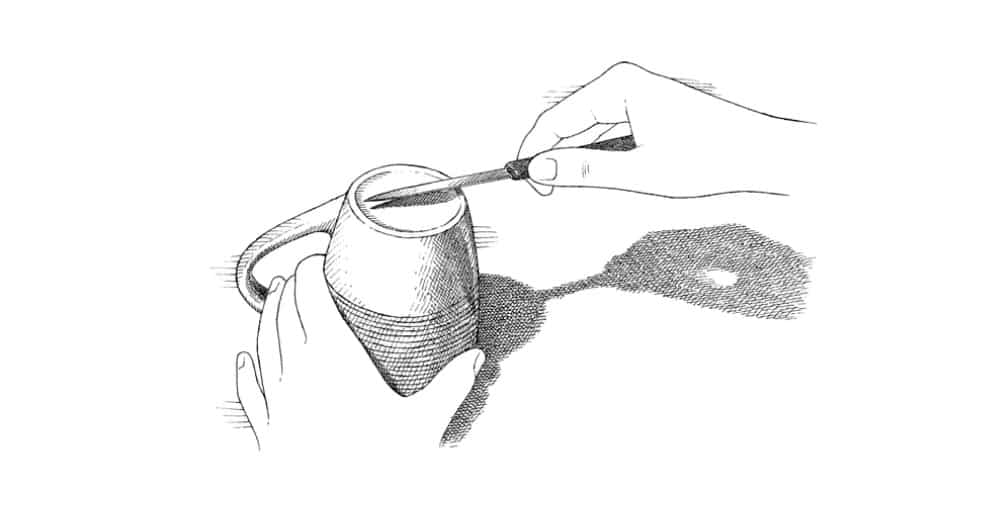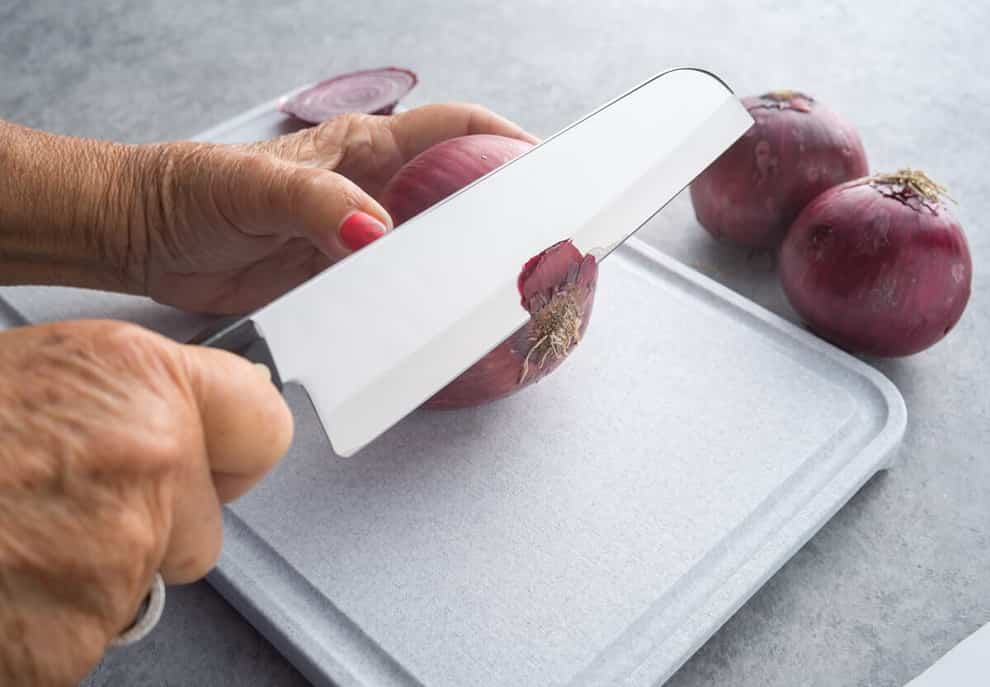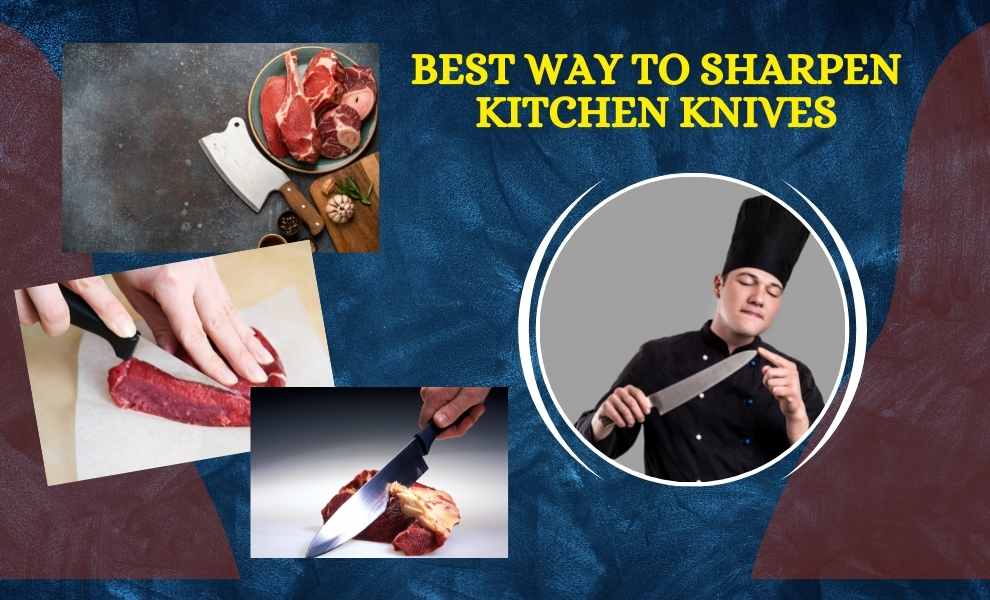Every product is independently reviewed and selected by our editors. If you buy something through our links, we may earn an affiliate commission.
Cooking is the only art that we can learn without going to any guru. So, most home chefs also don’t know why they sometimes need to put more pressure on their kitchen knives.
It happens every few weeks, and it happens regularly; it happens because they don’t know what is the best way to sharpen kitchen knives.
Sharpening a knife seems to be very difficult for them. But, if you want to cut your cooking ingredients into thin slices and nice dices, keeping your fingers in good shape, you have to keep your knives sharp.
You should know that a dull knife is dangerous. It requires more force, and slippage is a common thing while cutting with a dull knife.
On the other hand, a sharp knife is a safe knife. No extra pressure, no slippage, and no accident happens when your knife is sharp. So, let’s follow these ways and sharpen your kitchen knives with minimal effort.
5 Best Ways To Sharpen Kitchen Knives
There are dozens of ways to sharpen your chef knives, and you’ll be surprised to know that asking someone else to do the job is the easiest option.
Yep, my sweetheart always asks me to do it, and it’s my pleasure to help her in the kitchen.
Using an electric sharpener is the best way to sharpen kitchen knives. Anyway, you can sharpen your knives using a whetstone, or using a sharpening rod.
- Easy 3-stage sharpening system for professional results at home, anytime.
- Sharpens kitchen and sport knives, even Santoku knives.
- Blade thickness selector adjusts guides to optimum sharpening angle.
- Select thick for hunting knives, medium for chef’s knives and standard kitchen knives, and thin for light blades like fillet and paring knives.
- Blade guides hold knife at the perfect angle for no-guess sharpening.
Even a coffee mug or your ceramic dinner plate can be used as a fantastic knife sharpener. Sounds crazy, right? But, it’s so easy to do the job.
Every method has its pros with some drawbacks. So, the best sharpening process for you actually depends on your own preference. Now, I’m going to show you a few of the most common methods, any of which can be yours.
How To Sharpen Kitchen Knives Using An Electric Knife Sharpener
Using an electric knife sharpener is the best and fastest way to get the job done. It is also a great option to keep knives sharp.
The process is very easy –
- Place the edge of your knife in the first slot/coarsest wheel
- Slide it through the slot,
- Slide twice each side of your knife and
- Repeat the process on the second and third slots
- Then wash and finally dry your knife before use
- You can also test the sharpness before washing
It takes less than 10 seconds to give you the sharpness that you may get after 10 minutes of using a whetstone.
The user manual will tell you everything about your electric sharpener. You can also watch YouTube videos to get a clearer concept.
This type of knife sharpeners can bring the edge of your knives back to new condition, and these sharpening tools are user-friendly for both professional cooks and home chefs.
Moreover, they will help you save time and protect your knives from damage by offering smooth and consistent metal removal.
Using this sharpener requires no pro skills. Just plug and play to sharpen your knife. But, it’ll be better for you to be familiar with the sharpener if you are going to use it for the first time.
As you know, electric knife sharpening machines are the most efficient sharpeners. But, it can sharpen only one side of your knife at a time.
So, you’ll need to turn around the machine to sharpen both sides of your boning knife. Experts follow other techniques, but it’s safer and recommended for new users.
Most of the automatic sharpeners come with three grinding wheels. The first one is the coarsest one which is suitable for sharpening, and the other two wheels are used to hone and polish the edge.
You may fall in love with this type of knife sharpener. But, there’s a risk of over-sharpening. So, you should not slide your knife more than twice on each slot. You may slide once more if the result shows that your knife is not sharp enough.
Moreover, this sharpening machine is a bit expensive. So, if there’s no issue in your budget, Chef’sChoice Electric Knife Sharpener can be another excellent addition to your kitchen.
How To Sharpen Kitchen Knife Using Manual Knife Sharpener
Another common sharpening tool is the manual knife sharpener. It’s not suitable for novice cooks. But, you can use it only after 10 minutes of practice.
In this type of sharpener, the abrasive material is installed into a V-shaped slot. So, this sharpener is also known as V-Sharpener.
In an electric sharpener, you just need to slide the knife through the slot. But, in a manual sharpener, you’ll have to pull the edge of your knife through the V-slot towards you with pressure.
As the slot is in V-shape, it can sharpen both sides at a time. But, you’ve to hold the knife in a perfect angle. Otherwise, you’ll eventually blunt the knife. Anyway, this type of sharpener comes with two slots.
The first slot is coarse, and it’s made of carbide for sharpening the blade, and the other slot is made of ceramic material, which is fine and used to polish or fine-tune the knife. This sharpening tool provides a quick-fix solution to your dull knife.
You shouldn’t use this type of sharpener to any expensive knives until you’re skilled enough to hold the knife at the right angle with exact pressure.
Anyway, the price of a manual sharpener will surprise you. So, you can buy one and start honing your sharpening skill with an old knife today.
How To Sharpen Kitchen Knife Using A Stick Sharpener
A Stick sharpener is a very effective tool to take care of your kitchen knife. It comes with two types of sticks. One is carbide, and another one is a ceramic stick.
The carbide stick is coarse and sharpens your knife, and the ceramic stick is fine and does the same thing as the second slot of the V-sharpener offers.
It may seem a bit difficult for amateur chefs to use this sharpener. But, after a few hours of practice, you’ll start loving it. It’s one of the most favorite sharpening tools for serious cutler and home chefs. It’s also very easy to use.
First, you’ll have to set up the sticks into its predefined slots; then, you have to hold your knife edge straight down and just drag the edge nice and easy down both sides. This doesn’t take a lot of pressure to sharpen your knife.
Moreover, you don’t have to worry about your knife, angel. The sharpening sticks are already set up at a twenty-degree angle. So, you can easily hold your knife straight.
Another surprising fact about stick sharpeners is that they will probably last your entire life, and if you buy your sticks from Spyderco, they’ll give you an instruction book and DVD showing A to Z on using their sharpening sticks.
How To Sharpen Kitchen Knife Using A Whetstone
Whetstone is another favorite option to sharpen your chef knives. It’s a human-made stone in a rectangular shape that can sharpen ceramic knives or almost any type of knife. This sharpener also comes with two sides- fine-grind and coarse-grind side.
There are two types of whetstone available in the market. One is needed to be soaked in water before every use, and another one doesn’t require to be soaked.
But, nothing to worry about. Both work fine, and whether it needs to be soaked or not is mentioned in the manufacturer’s instructions. So, you can check the user manual to be sure.
To sharpen your knife using a whetstone, first, you’ve to put it on your countertop. Don’t forget to use a thick handkerchief or damp paper towels under the whetstone to make it stable. Now, face the knife away from you, holding it at a 20-degree angle with the whetstone bed.
The end of the cutting edge of your knife should be in the middle of the stone, and your other hand should be in the middle of the flat side of the knife.
Now drag the knife edge from Z to A on the whetstone, maintaining a 20-degree angle. Put some pressure to get the result.
Drag both sides of the cutting edge 5 to 10 times. As you know, this stone has two sides. Use the coarse-grind side first, and then drag your knife on the fine-grind side to polish it.
Now your knife is ready to cut any food. Just wash it and use it. Here’s my friend to show you how to sharpen a knife using a whetstone-
Sharpen Your Knife Using A Dinner Plate Or Coffee Mugs
What will be your answer if I ask you- is it possible to sharpen your knife without buying any sharpener?
My best answer is Yes. Yes, you can sharpen your knife without spending a dime. I’m sure there are dozens of dinner plates and coffee mugs in your home.
I know you love these ceramic beauties. Now, these ceramic beauties will help you sharpen your fancy knives or regular kitchen knives.

Take an old ceramic dinner plate or coffee mug, put it upside down on the countertop, and don’t forget to make it stable using paper towels or anything soft like that.
Yes, the procedure is the same as using a whetstone. Just replace the whetstone with your old or unused dinner plate if you want to keep your knives super sharp without spending any money.
You can’t imagine how effective this technique is. You’ll love it if you use it. A ceramic dinner plate or coffee mug can sharpen almost any type of chef knife. But, this DIY trick is not recommended if your knife is extremely blunt.
You can try it right now to test its effectiveness. It may take a bit more time as it’s not any regular sharpening tool. So, you’ll need to drag your knife edge 10 to 12 times. Actually, it depends on the dullness of the knife.
If you regularly hone your knife, then only 5 times of dragging is enough. Anyway, after dragging each side, you can test the sharpness. Now let’s see how to test the sharpness.
How To Test The Sharpness Of A Kitchen Knife
As you know, a dull knife can cause accidents at any time in your kitchen. So, it’s better to check the sharpness before every use, and there are several ways to check it.
The most common way is to use your thumbnail to check the sharpness. But, I personally don’t like this method as it may shed blood at a simple mistake. I usually take an onion to check the sharpness of my knives.

If your knife is not sharp enough, it’ll slip as soon as you put the cutting edge on the onion. And if it’s sharp enough, it’ll easily slice the skin of your onion.
You can also use a tomato to check the sharpness. If you can slice a tomato without creating any starter hole on the tomato skin, that means your knife is sharp enough to cut any food.
But, if there’s no tomato in your kitchen, or if you don’t need to cut any onion to make your breakfast, then there’s another way to check the sharpness.
Just hold a single folded newspaper with your left hand and put the knife edge on the top edge of the newspaper sheet at a 20-degree angle, and try to slice the paper. The edge of the slice will be clean if the knife is sharp.
How Often Do Kitchen Knives Need To Be Sharpened
A sharp knife is a safe knife. So, it’s your responsibility to keep your knife sharp all the time. No matter how expensive the knife is, it’ll dull if you use it. So, how often you should sharpen your knife depends on how frequently you use it.
There’s no common measurement. Sometimes, it needs to be sharpened in the middle of preparing food. When cutting brisket, meat, or other foods, you’ll feel it if your knife becomes dull. And if it becomes dull, it should be sharpened.
But, if you hone your knife before every use and if you’ve different knives for different use, then your knives may require to be sharpened only twice a year. Do you know the difference between honing and sharpening?
Do You Need To Wash The Knife After Sharpening
Cleanliness is next to godliness. If you like to cook and love to take pride in the cutlery you use, then it’ll be impossible for you to use your knife without washing it. So, definitely, you should clean your knife after sharpening.
While sharpening, it takes some metal off the edge of your knife to make it sharp. This metal gets mixed with the particle of dust generated from the carbide or ceramic slot of your sharpener and clinged with your knife. So, you should wash after sharpening.
You should also wash after honing if you hone using a whetstone or ceramic stick or regular knife sharpener. But, no need to wash your knife if you hone it with a steel rod. Just use a dry clean cloth to clean your knife.
Difference Between Honing And Sharpening A Knife
Yes, there’s a difference between honing and sharpening a knife, and that’s why there are two types of slots in every knife sharpener.
Honing a knife is not an alternative for sharpening, but regular honing ensures that you’ll have to sharpen your knife less often.
You can maintain sharpness with honing, but honing can not sharpen your knife. Let me make it clear with an example. What do you do with your teeth?
Now try to imagine that your knife has millions of micro teeth which are used to cut the food.
How often do you use your knife? Maybe it’s the most used tool in your kitchen, and because of this excessive use, those micro teeth become blunt, and your knife becomes unfit to properly slice any food.
Sharpening brings new teeth to your knife. Now tell me, why do you brush your teeth twice a day? Honing does the same thing to those micro teeth.
It makes those teeth sharp, but it can’t bring new teeth. If you regularly hone your knife, it’ll strengthen the sharpness.
You should sharpen your knife only when honing can not improve the performance of the knife, and your knife should be honed before every use. So, make your knife sharp first and then keep it sharp with honing.
Conclusion
There are dozens of methods to sharpen your knife. If you use expensive fancy knives, you’ll definitely use an electric knife sharpener. It’s the safest option to sharpen your knife.
If you use comparatively less expensive knives and don’t like to spend much on a sharpening tool, then a stick sharpener or even your unused ceramic coffee mug will be the best way for you to sharpen your kitchen knives. No matter how you sharpen it, just keep it sharp to make your cooking more enjoyable.


